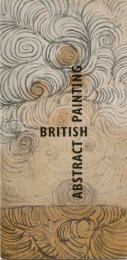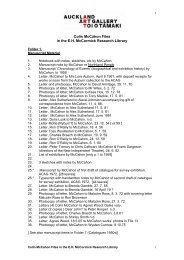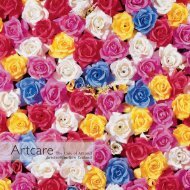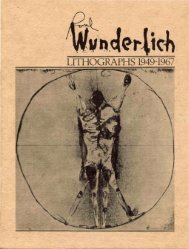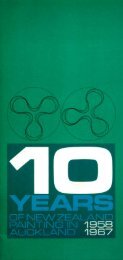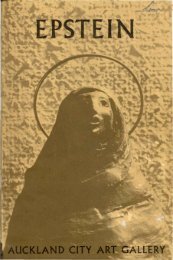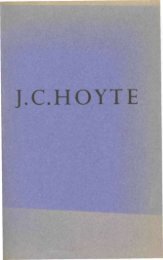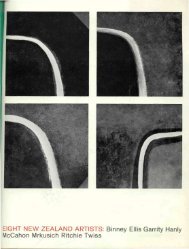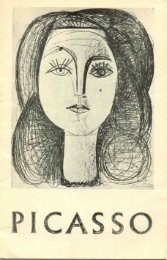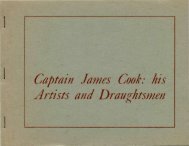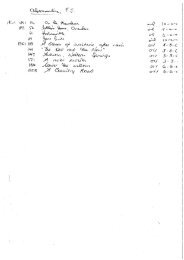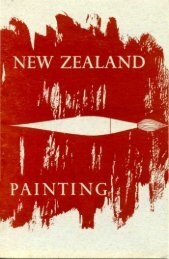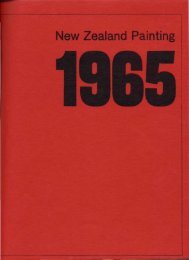Frances Hodgkins: Leitmotif - Auckland Art Gallery
Frances Hodgkins: Leitmotif - Auckland Art Gallery
Frances Hodgkins: Leitmotif - Auckland Art Gallery
Create successful ePaper yourself
Turn your PDF publications into a flip-book with our unique Google optimized e-Paper software.
24frances hodgkins at her bestdisparate hues facilitated by the use of powdercolours. 14 Mixtures included viridian green androse madder for skies in 1917, and a combinationof viridian, organic red and yellow, carbonblack and lead white for musty pink in Berries andLaurel 1930. Other pigments used by the artistin both water-based and oil-based paints wereearth colours: yellow ochre and Mars red; organics:yellow, red and rose madder; and inorganicpigments: artificial ultramarine, Prussian blue,chrome yellow, and lithopone (zinc sulphide andbarium sulphate). At least until the early 1920s,<strong>Hodgkins</strong> not only used lead white for highlightsin her watercolours and gouaches, but shealso mixed it with other pigments. A surprisingnumber of organic colours mixed with lead whitewere identified in the oil paintings from the1930s, particularly in Wings over Water. This mayindicate a less expensive brand of paint was usedas organic pigments tended to be cheaper, despitemany artists avoiding them because of questionsabout their permanency.<strong>Hodgkins</strong> was considered a leading BritishModernist by the 1940s, even though for most ofher life she had found it impossible to rely on herpainting alone and was forced to supplement herincome by teaching. Her poor financial situationand wartime shortages inevitably affected thechoice and the availability of materials. Friendsoften helped her out, not only because of the costbut also because of her preference for working inrural locations without well-stocked art suppliers.For this reason, the artist used whatever paperswere available for drawing and painting, althoughshe did obtain high quality materials from timeto time. The watercolour Ibiza – Study for oil 1935for example, is painted on a 100% fine cotton ragpaper produced by J Green & Son, who ran thefig.21 raking light highlights the changes tored jug (see also fig.1).fig.22 bradford-on-tone, geoffrey gorer’scottage 1940 gouache, auckland art gallerytoi o tâmaki, purchased 1970fig.23 photomicrograph of dry pigment mixedinto the paint bradford-on-tone, geoffreygorer’s cottagefig.24 watermark from the company fj head & coin transmitted light from ibiza – study for oil(watercolour)fig.25 detail of the loose weave canvas used forstill life with landscapeHayle Mill in Kent [fig.24], whereas the watercolourBoys heads, Treboul 1927 is painted on a poorquality machine-made paper. When she has usedcommercially prepared canvases they are oftenof a lower grade, being loose-weave with singlegrounds and lightweight stretchers [fig.25].<strong>Hodgkins</strong> certainly re-used papers and probablycanvas supports as well. There are faint images ofworks on the reverse of watercolours, Eggs & Fernsc.1931 and Phoenician Pottery & Gourds c.1933[fig.3] which have been rejected and wiped out,whereas in an earlier oil, The Edwardians c.1919,the artist has reused the canvas and stretcher ofanother work and painted over the top. 15The re-occurring practices identified in the workof <strong>Frances</strong> <strong>Hodgkins</strong> can be seen to display aleit-technique, where the use of watercolour isfundamental and has an influence throughouther career. Early oils and tempera paintings havea direct connection in their transparent colours,washes and calligraphic lines. Later the rapid andfluid brushstrokes of her oils and gouaches continuethe watercolour legacy. During <strong>Hodgkins</strong>’time in Paris, a change in her watercolour techniquefrom traditional washes to long brushworksaw a shift in focus from naturalistic representationto an interest in the paint materials and thesurface itself. This was then further developedin her use of opaque, textured oil and gouacheand in the use of colour, from brilliant transparencyto milky hues. Despite <strong>Hodgkins</strong>’ evocation`…that a good picture will out like MURDER…’the work seems effortless and retains a wonderfullyrical quality so desired by the artist. 16Sarah Hillary and Ute StrehleConservators<strong>Auckland</strong> <strong>Art</strong> <strong>Gallery</strong> Toi o Tamaki -



